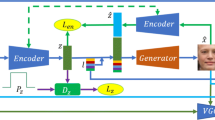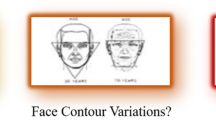Abstract
The appearance of a human face changes with the change in body weight and age. With varying lifestyle choices, it is hard to imagine the appearance of a given human face in years to come. Future self-perception is highly associated with one’s emotional state, as well as health behavior. Negative future self-perception can cause negative lifestyle choice and negative health behavior, leading to depression and eating disorder. In this paper, a new methodology is introduced for future self-face image synthesis using age and weight, resulting in visualization of future face image derived from given weight category and age. A Constrained Local Model is first used for weight progressed future face image synthesized and then age-progressed future face image is generated using Conditional Adversarial Auto Encoder. In the final step, both weight progressed and age-progressed face images fed to face morphing module which synthesized future face image by keeping natural looks. Experimental results show the advantages of proposed method with promising results.










Similar content being viewed by others
References
Coetzee V, Perrett DI, Stephen LD (2010) Deciphering faces: quantifiable visual cues to weight. Perception 39:51–61
Benson PJ, Emery JL, Cohen-Tovee EM, Tovee MJ (1999) A computer-graphic technique for the study of body size perception and body types. Behav Res Methods Instrum Comput 31:446–455
Harari D, Furst M, Kiryati N, Caspi A, Davidson M (2001) A computer-based method for the assessment of body-image distortions in anorexia nervosa patients. IEEE Trans Inf Technol Biomed 5:311–321
Sepulveda AR, Botella J, Leon JA (2002) Body image disturbance in eating disorders: a meta-analysis. Psychol Spain 6:83–95
Danino U, Kiryati N, Furst M (2004) Facial weight-change simulation. In: IEEE electronics, circuits and systems
Chen B-C, Hsu WH (2014) Cross-age reference coding for age-invariant face recognition and retrieval. In: Proceedings of the European conference on computer vision
UTK Face Dataset (2017). http://aicip.eecs.utk.edu/wiki/UTKFace
Saragih JM, Lucey S, Cohn F (2011) Deformable model fitting by regularized landmark mean-shift. J Int J Comput Vis 9:200–215
Cristinacce D, Cootes TF (2006) Feature detection and tracking with constrained local models. In: Bmvc
Zhang Z, Song Y, Qi H (2017) Age progression/regression by conditional adversarial autoencoder. arXiv:1702.08423
Tipping ME, Bishop CM (2002) Probabilistic principal component analysis. R Stat Soc 61:611–622
Bolme DS, Beveridge JR, Draper BA, Lui YM (2010) Visual object tracking using adaptive correlation filters. In: 2010 IEEE conference on computer vision and pattern recognition (CVPR)
Blanz V, Vetter T (1999) A morphable model for the synthesis of 3D faces. In: Proceedings of SIGGRAPH’99, pp 187-194
Rowland D, Perrett D (1995) Manipulating facial appearance through shape and color. Comput Graph Appl 15(259):70–76
Burt DM, Perrett DI (1995) Perception of age in adult caucasian male faces, computer graphic manipulation of shape and colour information. Proc R Soc Lond Ser B Biol Sci 259:137–143
Gandhi MR (2004) A method for automatic synthesis of aged human facial images. McGill University, Montreal (Ph.D. thesis)
Kemelmacher-Shlizerman I, Seitz SM (2012) Collection flow. In: Computer vision and pattern recognition
Liu C, Yuen J, Torralba A (2011) Sift flow: dense correspondence across scenes and its applications. IEEE Trans Pattern Anal Mach Intell 33:978–994
Kemelmacher-Shlizerman I, Suwajanakorn S, Seitz SM (2014) Illumination-aware age progression. In: Computer vision and pattern recognition
Shu X, Tang J, Lai H, Liu L, Yan S (2015) Personalized age progression with aging dictionary. In: Proceedings of the IEEE international conference on computer vision 3970–3978
Liang Y, Xu Y, Liu L, Liao S, Zou B (2011) A Multi-layer model for face aging simulation. In: Pan Z, Cheok AD, Müller W (eds) Transactions on edutainment VI. Lecture notes in computer science, vol 6758. Springer, Berlin
Du JX, Zhai CM, Ye YQ (2012) Face aging simulation based on NMF algorithm with sparseness constraints. In: Huang DS, Gan Y, Gupta P, Gromiha MM (eds) Advanced intelligent computing theories and applications. With aspects of artificial intelligence. ICIC 2011. Lecture notes in computer science, vol 6839. Springer, Berlin
Jiang F, Wang Y (2008) Facial aging simulation based on super-resolution in tensor space. In: International conference on image processing
Wang Y, Zhang Z, Li W, Jiang F (2012) Combining tensor space analysis and active appearance models for aging effect simulation on face images. IEEE Trans Syst Man Cybern Part B Cybern 42:1107–1118
Yang J, Tang H, Ma Y, Huang T (2008) Face hallucination via sparse coding. In: International conference on image processing
Yang J, Wright J, Huang TS, Ma Y (2010) Image super-resolution via sparse representation. IEEE Trans Image Process 19:2861–2873
Suo J, Zhu S-C, Shan S, Chen X (2010) A compositional and dynamic model for face aging. IEEE Trans Pattern Anal Mach Intell 32:385–401
Suo J, Chen X, Shan S, Gao W, Dai Q (2012) A concatenational graph evolution aging model. IEEE Trans Pattern Anal Mach Intell 34:2083–2096
Cootes TF, Edwards GJ, Taylor CJ (1998) Active appearance models. In: European conference on computer vision (ECCV)
Patterson E, Ricanek K, Albert M, Boone E (2006) Automatic representation of adult aging in facial images. In: International conference on visualization, imaging, and image processing
Patterson E, Sethuram A, Albert M, Ricanek K, King M (2007) Aspects of age variation in facial morphology affecting biometrics. In: International conference biometrics: theory, applications, and systems
Patterson E, Sethuram A, Albert M, Ricanek K (2007) Comparison of synthetic face aging to age progression by forensic sketch artist. International conference on visualization, imaging, and image processing
Patterson E, Sethuram A, Ricanek K, Bingham F (2009) Improvements in active appearance model based synthetic age progression for adult aging. International conference on biometrics: theory applications, and systems
Viola P, Jones M (2001) Rapid object detection using a boosted cascade of simple features. In: Computer vision and pattern recognition
Ramanathan N, Chellappa R (2006) Modeling age progression in young faces. In: Computer Vision and Pattern Recognition (CVPR)
Lin SD, Tu C-h, Chuang C-y, Lin H-t (2012) Aging simulation using facial muscle model. In: International conference on machine learning and cybernetics
Shen C-T, Lu W-H, Shih S-W, Liao H-YM (2011) Exemplar-based age progression prediction in children faces. In: International symposium on multimedia
Lanitis A (2008) Comparative evaluation of automatic age progression methodologies. J Adv Signal Process 2008:101. https://doi.org/10.1155/2008/239480
Wang J, Ling CX (2004) Artificial aging of faces by support vector machines. In: Tawfik AY, Goodwin SD (eds) Advances in artificial intelligence. Canadian AI 2004. Lecture notes in computer science, vol 3060. Springer, Berlin
Goodfellow I, Pouget-Abadie J, Mirza M, Xu B, Warde-Farley D, Ozair S, Courville A, Bengio Y (2014) Generative adversarial nets. In: Advances in neural information processing systems, pp 2672–2680
Radford A, Metz L, Chintala S (2016) Unsupervised representation learning with deep convolutional generative adversarial networks. In: International conference on learning representations
Mirza M, Osindero S (2014) Conditional generative adversarial nets, 1784. arXiv preprint arXiv:1411
Denton E, Chintala S, Szlam A, Fer R (2015) Deep generative image models using a laplacian pyramid of adversarial networks. In: Advances in neural information processing systems, 1486–1494, 9, 29th annual conference on neural information processing systems, NIPS 2015—Montreal, Canada
Suchanek P, Kralova Lesna I, Mengerova O (2012) Which index best correlates with body fat mass: BAI, BMI, waist or WHR. Neuro Endocrinol Lett 33:78–82
https://www.iwf.net/2018/07/05/new-bodyweight-categories-approved-iwf-executive-board/
Saragih JM, Lucey S, Cohn JF (2009) Face alignment through subspace constrained mean-shifts. In: 2009 IEEE 12th international conference on computer vision
Radford A, Metz L, Chintala S (2016) Unsupervised representation learning with deep convolutional generative adversarial networks. In: International conference on learning representations
Kingma D, Ba J (2014) ADAM: a method for stochastic optimization. arXiv preprint arXiv:1412.6980
Dlib C++ Library. http://dlib.net/
Wang Z, Bovik AC, Sheikh HR, Simoncelli EP (2004) Image quality assessment: from error measurement to structural similarity. IEEE Trans Image Process 13:600–612
Jiwa M, Burford O, Parsons R (2015) Preliminary findings of how visual demonstrations of changes to physical appearance may enhance weight loss attempts. Eur J Public Health 25:283–285
Kim Y, Sundar SS (2012) Visualizing ideal self vs. actual self through avatars: impact on preventive health outcomes. Comput Human Behav 28:1356–1364
Acknowledgements
This work is supported by the Postgraduate Research Grant (PPP) - Research and Grand Challenge - HTM (Wellness) from the University of Malaya under Grants PG210-2016A and GC003A-14HTM.
Author information
Authors and Affiliations
Corresponding author
Ethics declarations
Conflict of interest
The authors declare there is no conflict of interest.
Additional information
Publisher's Note
Springer Nature remains neutral with regard to jurisdictional claims in published maps and institutional affiliations.
Rights and permissions
About this article
Cite this article
Anwaar, M., Loo, C.K. & Seera, M. Face image synthesis with weight and age progression using conditional adversarial autoencoder. Neural Comput & Applic 32, 3567–3579 (2020). https://doi.org/10.1007/s00521-019-04217-6
Received:
Accepted:
Published:
Issue Date:
DOI: https://doi.org/10.1007/s00521-019-04217-6




